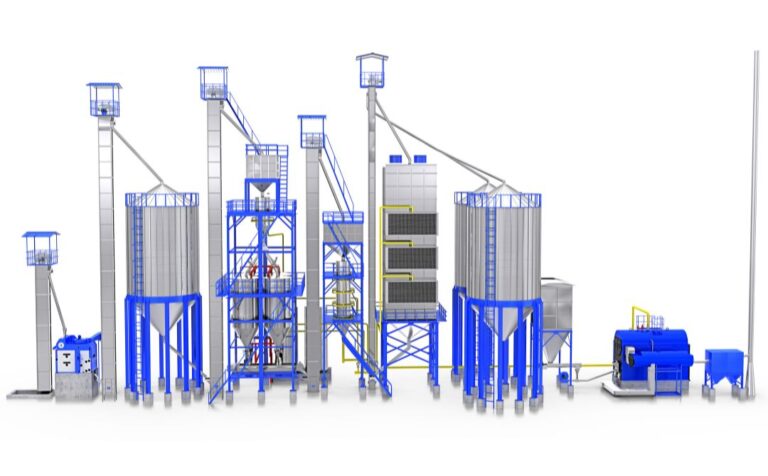Table of Contents
Rice, a dietary staple across India, fuels both homes and economies, with the nation producing over 120 million tonnes of paddy annually. As health awareness grows, consumers and rice manufacturers are increasingly choosing between parboiled rice and brown rice, each offering unique nutritional profiles and culinary qualities.
At SKF Elixer, we empower rice producers with advanced paddy processing plants, specializing in parboiling systems that enhance the nutritional and market value of parboiled rice. Our technology ensures rice manufacturers meet the rising demand for healthy, high-quality rice in domestic and export markets.
This blog explores the differences between parboiled rice and brown rice, focusing on their nutritional benefits, cooking properties, and suitability for various dietary needs. Whether you’re a rice miller in Andhra Pradesh, a cooperative leader in Punjab, or a health-conscious consumer in Mumbai, our insights will help you make informed decisions about rice production and consumption.
The Role of Rice in India’s Diet and Economy
Rice is consumed by over 70% of India’s population, contributing significantly to daily nutrition and the ₹5 lakh crore rice industry. Parboiled rice, favored in southern and eastern India, and brown rice, gaining popularity among urban health enthusiasts, cater to diverse preferences.
Parboiled rice accounts for 60% of India’s rice consumption, while brown rice is a growing niche in urban markets. A family of four consuming 10 kilograms of rice monthly can save ₹2,000–₹5,000 annually in healthcare costs by choosing nutrient-rich options, while rice manufacturers exporting parboiled rice earn ₹50,000 crore annually.
SKF Elixer’s parboiling plants, using hot water soaking and automated drying, produce high-quality parboiled rice with enhanced nutritional value, meeting Food Safety and Standards Authority of India (FSSAI) standards and boosting export potential.
What Is Parboiled Rice?
Parboiled rice is produced by soaking paddy in hot water (70–85°C), tempering, and drying before milling. This hydrothermal process gelatinizes the starch, driving nutrients from the bran into the endosperm, resulting in translucent, amber-colored rice.
Parboiled rice retains 80–90% of vitamins and minerals, offering a firmer texture and shorter cooking time (20–25 minutes) compared to raw rice.
What Is Brown Rice?
Brown rice is whole-grain rice with only the outer husk removed, retaining the nutrient-rich bran and germ. It has a chewy texture, nutty flavor, and longer cooking time (30–40 minutes). Brown rice is minimally processed, preserving its natural nutrient content but requiring careful storage to prevent rancidity due to its high oil content in the bran.
Parboiled Rice vs. Brown Rice: Key Differences
Understanding the differences between parboiled rice and brown rice helps consumers and manufacturers choose the best option for health and market needs.
1. Nutritional Value
- Parboiled Rice Nutrition: Retains 80–90% of nutrients due to parboiling. A 100-gram serving provides 350–360 kcal, 7–8 grams of protein, 0.4–0.6 mg thiamine (30–50% of daily needs), 2–3 mg iron, and 20–30 mg magnesium. It’s enriched with B vitamins and minerals, supporting energy metabolism and immunity.
- Nutritional Value of Brown Rice: Contains 360–370 kcal, 7–8 grams of protein, 0.5–0.7 mg thiamine, 1.5–2 mg iron, and 40–50 mg magnesium per 100 grams. Its bran layer adds fiber (1.8–2 grams) and antioxidants but loses some nutrients during milling compared to parboiled rice.
For a family consuming 10 kilograms monthly, parboiled rice offers comparable protein and thiamine but slightly less fiber, while brown rice provides more magnesium and fiber, reducing digestive health risks costing ₹2,000–₹5,000 annually.
2. Fiber Content
- Parboiled Rice: Has 1–1.5 grams of fiber per 100 grams, promoting satiety and digestive health but lower than brown rice.
- Brown Rice: Contains 1.8–2 grams of fiber per 100 grams, aiding digestion and reducing constipation risks, saving ₹1,000–₹2,000 annually in healthcare for a family.
3. Glycemic Index (GI)
- Parboiled Rice: Lower GI (38–50) due to gelatinized starch, making it better for blood sugar control, reducing diabetes-related costs by ₹3,000–₹5,000 annually for a family.
- Brown Rice: Moderate GI (50–60), better than white rice (70–89) but higher than parboiled, slightly less effective for diabetes management.
4. Cooking and Texture
- Parboiled Rice: Cooks in 20–25 minutes, yielding firm, non-sticky grains ideal for dishes like biryani. It’s easier to cook and store, reducing preparation time by 20–30%.
- Brown Rice: Takes 30–40 minutes to cook, with a chewy texture suited for salads or health-focused meals. Its longer cooking time increases energy costs by ₹500–₹1,000 annually for a household.
5. Shelf Life
- Parboiled Rice: Resistant to pests, extending shelf life by 6–12 months, reducing storage losses by ₹10,000–₹20,000 per 10 tonnes for rice manufacturers.
- Brown Rice: Prone to rancidity due to bran oils, limiting shelf life to 6–8 months, causing 2–3% losses (₹10,000–₹15,000 per 10 tonnes).
Is Parboiled Rice Healthier Than Brown Rice?
Both are healthier than white rice, but their benefits vary:
- Parboiled Rice Benefits: Higher thiamine and iron retention, lower GI, and better pest resistance make it ideal for diabetes management and long-term storage. It’s cost-effective for manufacturers, adding ₹5–10 per kilogram in export markets.
- Brown Rice Benefits: Higher fiber and magnesium content support digestive and heart health, appealing to urban consumers but requiring careful storage.
For diabetes, parboiled rice is better due to its lower GI, saving ₹3,000–₹5,000 annually in medical costs. For weight loss, brown rice’s higher fiber promotes satiety, but parboiled rice is comparable, making both viable options.
Brown Rice vs. Parboiled Rice for Weight Loss
- Parboiled Rice: Lower GI (38–50) and 1–1.5 grams fiber per 100 grams reduce hunger spikes, supporting weight loss. A family consuming 10 kilograms monthly can manage calorie intake better, reducing snacking costs by ₹1,000–₹2,000 annually.
- Brown Rice: Higher fiber (1.8–2 grams) enhances satiety, but its higher GI may cause quicker hunger pangs, slightly less effective for sustained weight control.
Difference in Cooking Parboiled Rice and Brown Rice
- Parboiled Rice: Cooks faster (20–25 minutes), requires less water (1:2 ratio), and yields non-sticky grains, saving ₹500–₹1,000 annually in cooking fuel for a household.
- Brown Rice: Takes longer (30–40 minutes) with a 1:2.5 water ratio, increasing energy costs and requiring precise cooking to avoid chewiness.
Benefits of Eating Parboiled Rice Daily
Parboiled rice offers:
- Nutritional Enrichment: 20–30% higher thiamine and iron, reducing deficiency risks and healthcare costs by ₹2,000–₹5,000 annually.
- Diabetes Management: Lower GI supports blood sugar control, saving ₹3,000–₹5,000 in medical expenses.
- Market Value: Translucent grains fetch ₹5–10 more per kilogram, boosting exports by ₹50,000 crore annually.
- Durability: Pest resistance saves ₹10,000–₹20,000 per 10 tonnes in storage losses.
Why Choose SKF Elixer?
With years of expertise, SKF Elixer delivers BIS-certified parboiling plants tailored for India’s rice varieties. Our options, support, and AMCs ensure reliability for rice manufacturers aiming for domestic and export markets.
Conclusion
Parboiled rice and brown rice offer distinct nutritional benefits, with parboiled rice excelling in diabetes management and storage, while brown rice supports digestive health. SKF Elixer’s parboiling plants produce high-quality parboiled rice, meeting consumer and export demands. Choose our solutions to enhance nutrition and profitability in India’s rice industry.
Ready to produce premium parboiled rice? Contact SKF Elixer to explore our tailored parboiling plants.
FAQs
-
1. Is parboiled rice healthier than brown rice?
Parboiled rice has a lower glycemic index (38–50) and higher thiamine (0.4–0.6 mg/100g), ideal for diabetes management, saving ₹3,000–₹5,000 annually in medical costs. Brown rice offers more fiber (1.8–2 g/100g) for digestion but is less pest-resistant.
-
2. What are the nutritional benefits of parboiled rice compared to brown rice?
Parboiled rice retains 80–90% of thiamine (0.4–0.6 mg/100g) and iron (2–3 mg), while brown rice has higher fiber (1.8–2 g) and magnesium (40–50 mg). Both provide 7–8 g protein, supporting health with different strengths.
-
3. What is the difference in cooking parboiled rice and brown rice?
Parboiled rice cooks in 20–25 minutes with a 1:2 water ratio, saving ₹500–₹1,000 annually in fuel. Brown rice takes 30–40 minutes with a 1:2.5 ratio, increasing energy costs and yielding a chewier texture.
-
4. Which is better for diabetes – parboiled rice or brown rice?
Parboiled rice’s lower GI (38–50) is better for blood sugar control, reducing diabetes-related costs by ₹3,000–₹5,000 annually compared to brown rice (GI 50–60), making it a preferred choice for diabetics.
-
5. How does parboiled rice vs. brown rice aid weight loss?
Parboiled rice (1–1.5 g fiber/100g, GI 38–50) and brown rice (1.8–2 g fiber, GI 50–60) both promote satiety, but parboiled rice’s lower GI reduces hunger spikes, saving ₹1,000–₹2,000 annually in snacking costs.
Good reads are meant to be shared









